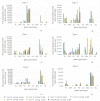Zoning Optimization Method of a Riverfront Greenspace Service Function Oriented to the Cooling Effect: A Case Study in Shanghai
- PMID: 36498265
- PMCID: PMC9738997
- DOI: 10.3390/ijerph192316191
Zoning Optimization Method of a Riverfront Greenspace Service Function Oriented to the Cooling Effect: A Case Study in Shanghai
Abstract
Blue-green space commonly provides multiple ecological service functions, especially thermal environment comfort for citizens. The greenspace of the riparian buffers along 22 river channels in Shanghai was selected as the study object, and remote sensing and GIS technologies were used to obtain the quantitative composition and morphological indices of riverfront greenspace and the spatial distribution data of the land surface temperature in the study area. Through BRT modelling and statistical analyses, the interactive correlations among the three aspects, namely, the spatial patterns of riverfront greenspace, their specific functional zoning, and cooling island differentiation characteristics, were explored. The results showed that different river types served for different functional zones of the city, namely, high-density built-up zoning, new urban-growth zoning in built-up areas, suburban areas, and rural areas, and had specific regular patterns of morphosis and service function of riverfront greenspace. These also led to a significant spatial differentiation pattern of cooling intensity levels, which generally appeared in the approximate circle differentiation structure of the cooling island in the city riverfront area. The study further proposed the key factors and corresponding strategies for optimizing the greenspace pattern to strengthen the cooling intensity levels of different river types. This study summarizes the landscape composition paradigm of riverfront greenspaces at the urban mesoscale and provides adaptive planning methods for better local microclimate conditions.
Keywords: Shanghai; blue–green space; boosted regression trees (BRT); marginal effect (ME); riverfront area; spatial morphology; urban cooling effect (UCI); urban heat island (UHI).
Conflict of interest statement
The authors declare no conflict of interest.
Figures











Similar articles
-
Interaction of Urban Rivers and Green Space Morphology to Mitigate the Urban Heat Island Effect: Case-Based Comparative Analysis.Int J Environ Res Public Health. 2021 Oct 29;18(21):11404. doi: 10.3390/ijerph182111404. Int J Environ Res Public Health. 2021. PMID: 34769917 Free PMC article.
-
Cooling Island Effect of Blue-Green Corridors: Quantitative Comparison of Morphological Impacts.Int J Environ Res Public Health. 2021 Nov 13;18(22):11917. doi: 10.3390/ijerph182211917. Int J Environ Res Public Health. 2021. PMID: 34831672 Free PMC article.
-
Spatial patterns of greenspace cool islands and their relationship to cooling effectiveness in the tropical city of Chiang Mai, Thailand.Environ Monit Assess. 2019 Aug 21;191(9):580. doi: 10.1007/s10661-019-7749-9. Environ Monit Assess. 2019. PMID: 31435832
-
Cooling strategies for thermal comfort in cities: a review of key methods in landscape design.Environ Sci Pollut Res Int. 2021 Nov;28(44):62640-62650. doi: 10.1007/s11356-021-15172-y. Epub 2021 Jul 1. Environ Sci Pollut Res Int. 2021. PMID: 34196867 Review.
-
[Planning approach of urban blue-green space based on local climate optimization: A review].Ying Yong Sheng Tai Xue Bao. 2020 Nov;31(11):3935-3945. doi: 10.13287/j.1001-9332.202011.014. Ying Yong Sheng Tai Xue Bao. 2020. PMID: 33300745 Review. Chinese.
References
-
- Deng Y., Song D. Analysis the psychological need of people in waterside urban landscape design. Urban Dev. Stud. 2008;15:51–53. doi: 10.3969/j.issn.1006-3862.2008.03.017. (In Chinese) - DOI
-
- Zhang A.Q. Master’s Thesis. Huazhong University of Science and Technology; Wuhan, China: 2010. Research on mountainous city riverfront space design. (In Chinese) - DOI
-
- Dai F., Wang Y., Chen M., Huang Y., Guo L. Study on the planning and protection of waterfront green space under the vision of “Park City”: A case study of hundreds-kilometers riverbank parks group of the Yangtze river in Wuhan. Shanghai Urban Plan. Rev. 2019:19–26. doi: 10.11982/j.supr.20190104. (In Chinese) - DOI
-
- Zhou J., Huang Y. Content and methodology of ecological planning of waterfront green space in China’s cities. City Plan. Rev. 2007:63–68. doi: 10.3321/j.issn:1002-1329.2007.10.012. (In Chinese) - DOI
-
- Dokulil M.T., Donabaum K., Teubner K. The Alte Donau: Successful Restoration and Sustainable Management-An Ecosystem Case Study of a Shallow Urban Lake. Springer International Publishing AG; Cham, Switzerland: 2018. pp. 355–371. - DOI
MeSH terms
Grants and funding
LinkOut - more resources
Full Text Sources

